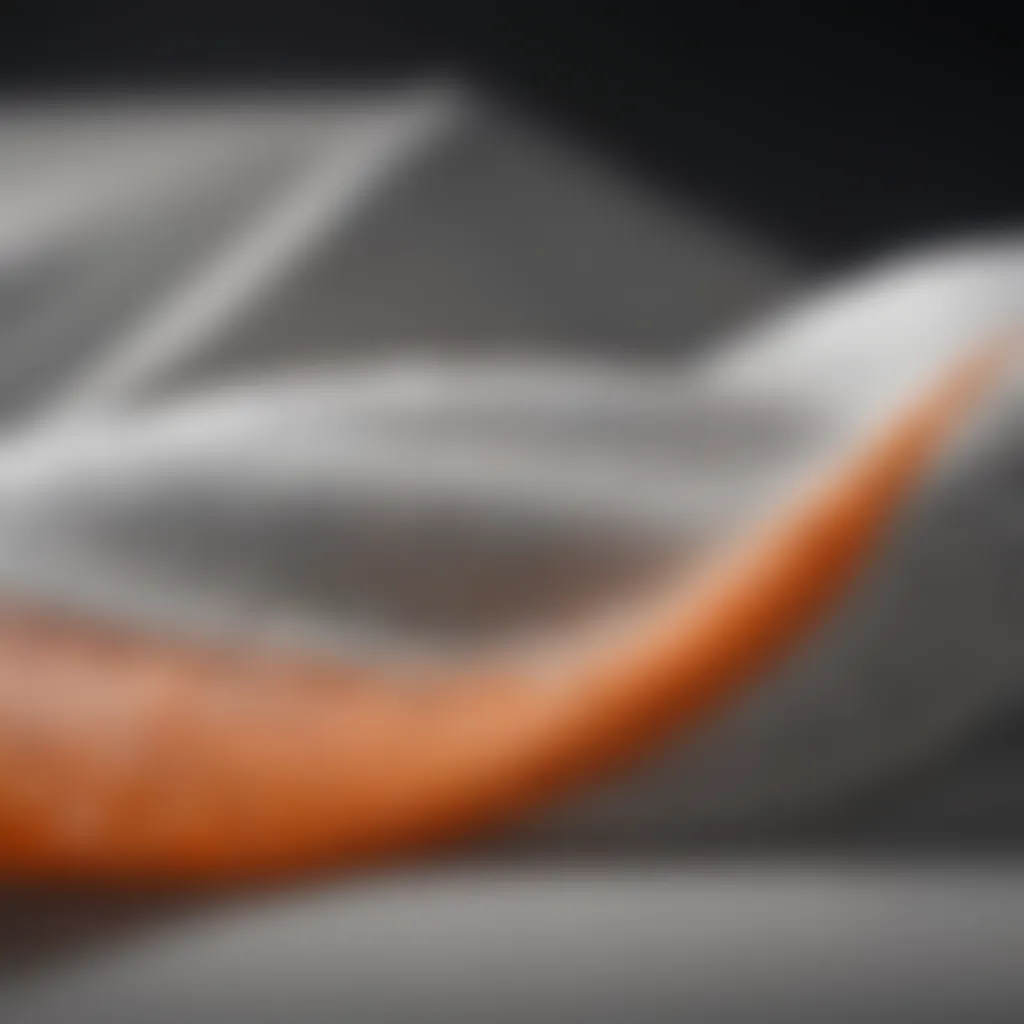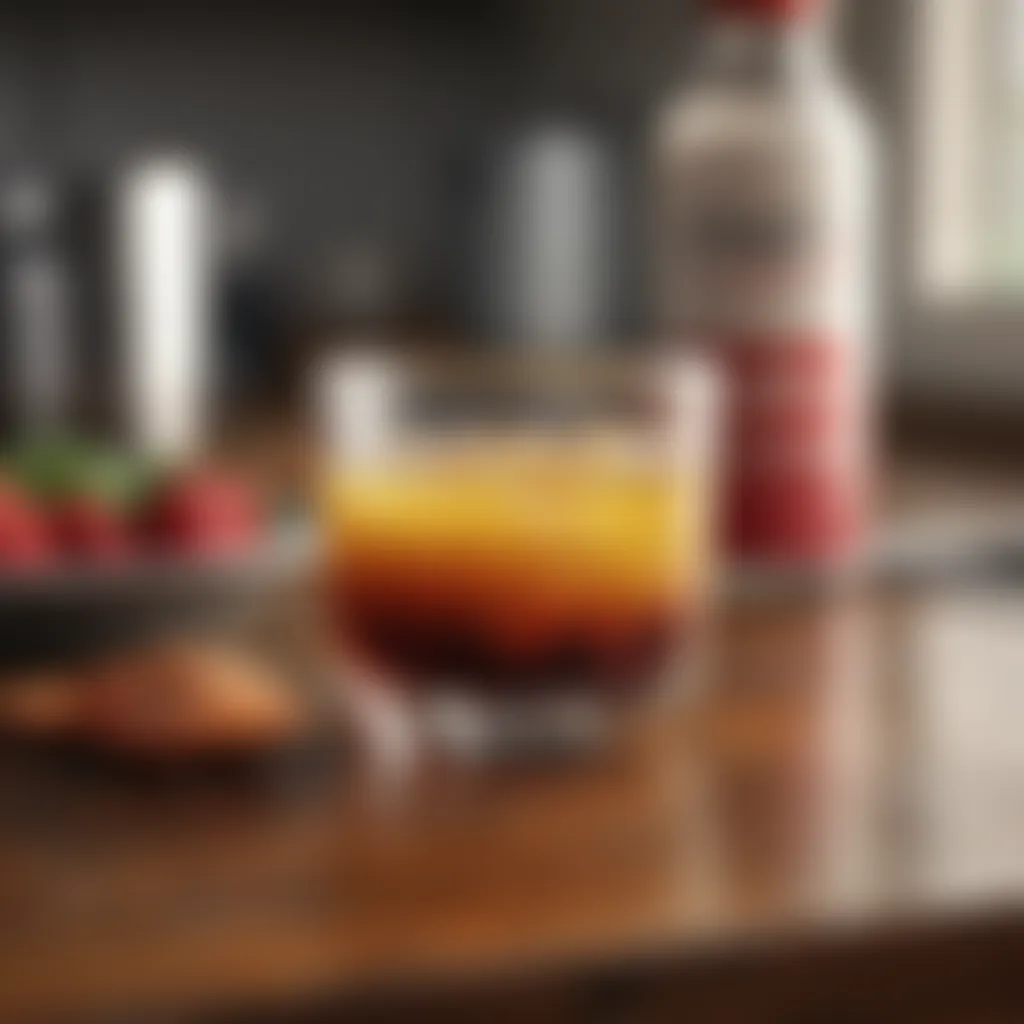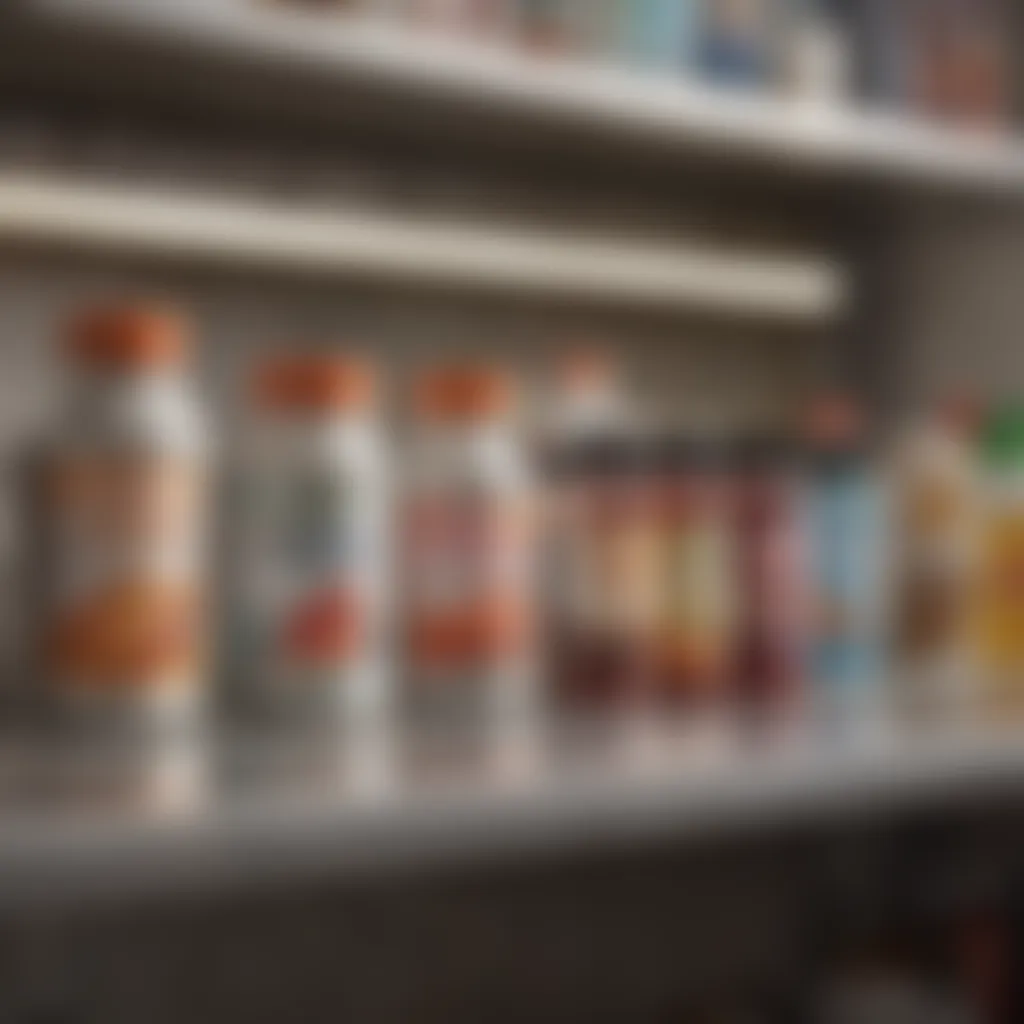Effective Strategies for Removing Sweat Stains


Intro
Sweat stains on clothing can be an absolute headache, especially after a long day in the sun or an intense workout. They not only leave unsightly marks but can also create lingering odors if left unaddressed. While it’s easy to simply toss the affected items in the wash, without proper strategies, those stains might stick around like unwanted guests.
In this comprehensive guide, we will explore a multitude of effective strategies to combat sweat stains. From understanding the chemistry behind sweat and its interactions with fabric fibers to employing both homemade remedies and commercial solutions, we’ll ensure you’re well-equipped to tackle this common laundry woe.
Being prepared is half the battle, and knowing how to act promptly can save your favorite garments from permanent damage. So, let’s dive into the details and equip you with the knowledge you need to maintain a spotless wardrobe, even in the face of sweat stains.
Understanding Sweat Stains
When it comes to tackling the problem of sweat stains, the initial understanding is crucial. It sets the stage for effective strategies in handling those embarrassing marks on your favorite clothes. Understanding sweat stains means knowing what they are, how they form, and what contributes to their persistence. This knowledge allows anyone, especially housewives juggling family responsibilities, to approach laundry with informed strategies.
The Composition of Sweat
Sweat is primarily made of water, but it is not just plain O. It is mixed with salts, urea, lactate, and various other compounds. This unique blend is what makes sweat stains particularly notorious. The salt can lead to a crusty build-up when sweat evaporates, causing a permanent stain on clothes. Moreover, our diet, medication, and personal health can influence the composition of sweat, meaning not every stain is created equal. For instance, someone with a higher protein intake might find their sweat has a different impact compared to a person with a plant-based diet.
How Sweat Affects Fabrics
Fabrics vary widely, from cotton to nylon, each reacting differently when sweat meets cloth. The natural fibers like cotton tend to absorb moisture more readily, allowing for expansion and potential staining. Synthetic fibers, while less absorbent, may hold odor due to their less breathable quality. Understanding these interactions helps to choose the right solutions for removable methods tailored to the fabric type.
Factors Influencing Stain Severity
Several factors can amplify the severity of sweat stains, and knowing them can give an edge in preventing permanent damage. Let's break these down:
Fabric type
Different fabrics react uniquely to sweat. For example, cotton is well-loved for its breathability but is prone to absorbing sweat deeply. This means the stain can set in quickly if not addressed. Synthetic fabrics, on the other hand, don’t absorb as much moisture but can trap bacteria and odors, leading to persistent stains. Choosing lighter, breathable fabrics can make life easier in hot conditions, reducing stain severity from the get-go.
Heat and humidity
Heat and humidity play a significant role in sweating itself. High temperatures often lead to increased perspiration, and, together with humidity, can leave sweat clinging to clothes longer than intended. This can create an unbearable situation at family gatherings or outings, turning enjoyable moments into worrying occasions. Selecting the right time to wear specific clothing can minimize unwanted stains, especially during the summer months.
Personal hygiene
A's purely personal as they come, hygiene habits directly influence how sweat interacts with fabrics. Regular bathing and application of antiperspirants can significantly reduce sweat and bacteria accumulation. Therefore, the less sweat resting on garments, the lower the chances of persistent staining. Encouraging a regular wash of clothing mixed with these practices forms part of the long game in stain removal strategies and maintenance.
"An ounce of prevention is worth a pound of cure."
Immediate Response Techniques
When faced with sweat stains on clothing, the speed of your response can be as crucial as the method you employ for removal. Immediate action not only mitigates the problem but can also prevent permanent damage to your garments. This section explores three key techniques for dealing with sweat stains effectively.
Acting Quickly
The old saying goes, "Strike while the iron's hot," and this couldn't be more relevant when tackling sweat stains. The moment you notice a stain forming, it's imperative to act swiftly. The longer you wait, the more ingrained the stain becomes. If left unchecked, sweat can cause fabrics to deteriorate and leave behind unsightly discoloration.
In practical terms, this means keeping an eye on your clothing after any activity that induces sweating. By prioritizing inspection and swift action, you can save yourself the headache of dealing with stubborn marks later on. Having a designated spot in your laundry area for quick stain treatment can help reinforce this practice, ensuring that no stain falls through the cracks.
Rinsing with Cold Water
Once you've acknowledged the stain, your next step should be rinsing the affected area with cold water. Cold water serves as a gentle yet effective means to lift the sweat and its accompanying salts from the fabric.


- Why Cold Water?Using cold water has the advantage of reducing the stain's ability to set. Unlike hot water, which can further embed the stain into the fabric fibers, cold water gently washes away the initial traces of sweat. Moreover, it helps maintain the integrity of many delicate materials.
- Technique Overview:Begin by running cool water directly over the stained area. Avoid scrubbing; instead, let the water do the work for a few minutes. You want to dilute the sweat, making it easier to manage later on.
Blotting vs. Rubbing
When it comes to treating sweat stains, understanding the difference between blotting and rubbing is fundamental.
- Blotting:Blotting is a gentle technique aimed at lifting the stain without damaging the fabric's fibers. Use a clean cloth or paper towel to dab the stained area. This helps absorb the moisture without spreading the stain further, which can often occur if one rubs the fabric aggressively.
- Rubbing:On the other hand, rubbing may seem like an intuitive response. However, it's a risky maneuver. Rubbing can cause pilling, fraying, or even tearing, especially in delicate fabrics. It can also cause the stain to deepen into the fabric, making it tougher to remove.
Tip: Always use a light touch when handling sweat stains. A careful approach can preserve the garment's lifespan while effectively dealing with stains.
In summary, responding quickly, rinsing with cold water, and opting for the gentle technique of blotting over rubbing can work wonders in combating sweat stains effectively. Incorporating these immediate response techniques into your routine can make a world of difference in maintaining your clothing.
Household Remedies
When it comes to dealing with sweat stains, there’s a strong case to be made for using household remedies. These solutions not only save you a trip to the store but also often use items you likely already have at home. The benefits are manifold; first, these ingredients tend to be cheaper than dedicated stain removers, and second, they are generally less harmful to both the environment and your fabrics. With a little ingenuity, you can transform common household products into powerful allies in your battle against stubborn stains.
Many household items can double as effective stain removers, proving that sometimes the simplest solutions are the best.
Baking Soda Applications
Baking soda is one of those items that proves its worth time and again in the kitchen and beyond. Known for its absorbent qualities, it can help lift sweat stains and odors from fabric effectively. To harness its power, create a paste using equal parts baking soda and water. This thick mixture can then be applied directly to the stained area. Let it sit for about 30 minutes to allow the magic to happen before rinsing it out. The baking soda not only helps to lighten the stain but also deodorizes the fabric, leaving it smelling fresh.
- Another option is to add a cup of baking soda to your laundry during the wash cycle, which can enhance the overall cleaning power of your detergent, making it a solid choice for preventing future stains.
Vinegar and its Efficacy
Vinegar might seem like an unconventional choice, yet it has proven remarkably effective in tackling sweat stains. It acts as a natural fabric softener and stain remover, breaking down the elements of sweat that cause discoloration. For best results, mix one part white vinegar with two parts water in a spray bottle. Spritz the solution onto the stained fabric and let it sit for about 30 minutes before laundering as usual. This method not only fights stains but also removes any lingering odors, giving you fresher clothes.
- White vinegar is safe for most fabric types and can be particularly effective on cotton and synthetic blends.
Hydrogen Peroxide Solutions
Hydrogen peroxide can be a powerful stain-fighting agent. Often regarded as a versatile cleaner, it excels at removing tough stains due to its oxidizing properties. Create a mixture by combining one part hydrogen peroxide with two parts water. Like vinegar, this solution can be sprayed onto the affected area and left to work for around 30 minutes before washing. Caution is advised when using this method, as hydrogen peroxide can lighten some fabrics. It’s always a good idea to test it on a hidden area first to ensure no unwanted color changes occur.
- This treatment is best reserved for white or light-colored fabrics, as darker materials may be at risk of fading.
Lemon Juice as a Natural Stain Remover
Lemon juice, with its natural acidity, can effectively brighten and clean fabrics. This option not only addresses sweat stains but also offers a refreshing scent. Squeeze fresh lemon juice directly onto the stain and then sprinkle salt over it, creating a gentle abrasive effect. Let it soak in the sun for a couple of hours before laundering. The combination of the acidic juice and sunlight works in tandem to naturally bleach the fabric, helping to lift away unsightly marks.
- Lemon juice can be particularly potent on white clothing but, like hydrogen peroxide, should be used with caution on darker fabrics.
With these household remedies at your disposal, you can reclaim your clothes from the clutches of sweat stains effectively while also practicing a bit more sustainability. The use of common items around your home not only minimizes waste but also empowers you to take on laundry challenges easily.
Commercial Stain Removers
Removing sweat stains can be a persistent challenge, and at times, household remedies may not cut it. That’s where commercial stain removers come into play. These products are specifically engineered to tackle tough stains, including those pesky marks caused by perspiration. Understanding the spectrum of stain removers available on the market can help you make an informed decision that fits your fabric needs.
Overview of Different Products
Sweat stain removers come in a variety of forms, such as sprays, gels, and powders. Each of these products boasts unique formulations that promise to lift stains effectively. Some well-known products include OxiClean MaxForce Spray, Zout Laundry Stain Remover, and Shout Advanced Gel. These can be found in most grocery stores bustling with options. The advantage of these commercial products is they often contain enzymes or other active ingredients that break down stains more effectively than typical detergents.
Choosing the Right Stain Remover


Finding the right stain remover can feel a bit like looking for a needle in a haystack. Here are some considerations to help narrow your search:
Consider fabric compatibility
When selecting a stain remover, considering fabric compatibility is crucial. Different fabrics have varying levels of durability and sensitivity. For example, a strong stain remover might work wonders on cotton but could damage delicate silk. Knowing the fiber content of your clothing can help you pick a remover that's neither too harsh nor too gentle. Utilizing a product designed specifically for your garment's fabric will usually yield more effective results.
Reading product labels
Reading product labels is a skill that cannot be underestimated. A careful look at ingredient lists can save you a world of trouble. Many stain removers carry instructions and precautions based on fabric type. Furthermore, key features like "safe for colors" or "for tough stains" can guide your decision-making process. By taking a moment to read what’s on the label, you arm yourself with necessary knowledge and reduce the risk of setting your laundry back instead of helping it.
Environmentally conscious choices
In recent years, shoppers have become more interested in environmentally conscious choices. Many companies have responded with sustainable products that are kinder to the environment yet effective against stains. These stain removers usually utilize natural ingredients as opposed to harsh chemicals. By opting for eco-friendly options, you’re not just benefiting your fabrics, but you’re also making a responsible choice for the planet. Products labeled as biodegradable, cruelty-free, or made from natural components can be sought after and frequently appreciated by mindful consumers.
Application Techniques for Effectiveness
To truly get the most out of commercial stain removers, application is key. Here are some techniques:
- Pre-treating: Applying the product directly to the stain ahead of a wash can penetrate deeper.
- Gentle scrubbing: Sometimes a soft brush can help lift stains more effectively.
- Timing: Allowing the product to sit on the stain for a specified amount of time without letting it dry can enhance the effectiveness.
Ultimately, commercial stain removers give you a fighting chance in the never-ending battle against sweat stains. By being selective and well-informed about your choices, you can keep your clothes fresh and stain-free.
Preventive Measures
When it comes to sweat stains, the old adage rings true: an ounce of prevention is worth a pound of cure. Preventive measures play a vital role in keeping our favorite clothes fresh and stain-free. By understanding the right materials to choose, the proper usage of antiperspirants, and maintaining consistent laundry habits, we can significantly reduce the chances of stubborn sweat marks cropping up.
Choosing the Right Fabrics
The first step in sweat stain prevention begins with selecting clothing made from breathable fabrics. Materials such as cotton or linen allow air to circulate, helping skin stay cool and dry. On the other hand, synthetic fabrics like polyester can trap moisture, making it a prime environment for sweat stains to form.
Opting for light-colored clothes can also be beneficial; they tend to disguise stains better than dark colors. For instance, a white cotton shirt will hide a bit of perspiration much more effectively than a navy blue one. Additionally, be mindful of the fit. Loose-fitting clothes can also help air flow better, reducing sweat buildup.
Using Antiperspirants Wisely
Not all antiperspirants are created equal. Choosing the right product and using it effectively can make a significant impact in preventing sweat stains. Opt for clinical strength formulas if regular products are not cutting it. Generally, applying antiperspirant at night rather than in the morning allows it to work more effectively, as the body's temperature tends to rise during the day, which can encourage sweating.
Besides proper application, consider the frequency of use. Sometimes, a little extra application during particularly hot days or stressful events—like a job interview or a wedding—can set a strong foundation for sweat control. Remember, practice makes perfect; finding the right product and applying it in the right way can lead to a sweat-stain-free wardrobe.
Regular Washing Routines
Establishing a regular washing schedule can go a long way in maintaining the integrity of your clothes. Sweat can often dry quickly and set into fabric, which means that letting clothes sit in the hamper for too long can lead to permanent stains. Aim to wash your shirts and other sweating-prone items after each wear, especially during hot and humid weather.
When washing, avoid using hot water which can set stains, and instead, go for cold or lukewarm. Always check labels for specific washing instructions, as some fabrics may require gentler treatments or special settings to keep their structure intact. Finally, try to air-dry clothes whenever possible; the heat from a dryer can sometimes react with the detergent and any residual stains, making them more challenging to remove later.
Takeaway: Choosing breathable fabrics, applying antiperspirants correctly, and having a consistent washing routine can help keep those unsightly sweat stains at bay, ensuring that your wardrobe stays fresh and colorful.
Long-Term Solutions
When it comes to managing sweat stains, the best approach often lies in looking ahead. Long-term solutions provide not just relief from current stains but also preventive measures that shield your favorite garments from future mishaps. Achieving fabric longevity while keeping them vibrant requires a mix of thoughtful choices and practical actions.
Stain-Resistant Fabrics
Investing in stain-resistant fabrics is more than just a smart move; it’s like wearing armor against those pesky sweat stains. Materials engineered to repel moisture can help ensure that the gym or the hot summer day does not equate to permanent discoloration. Look for fibers that are treated with water-repellent coatings or fabrics renowned for their moisture-wicking capabilities, such as polyester or nylon blends.


- Benefits of Stain-Resistant Fabrics:
- Reduce the frequency of deep cleaning, which saves both time and money.
- Maintain the appearance of your clothes longer, enhancing their wearability.
- Often require less ironing, simplifying laundry routines.
When choosing new garments, carefully examine product labels. Fabrics labeled as "moisture-wicking" or "stain-resistant" could be especially beneficial for active lifestyles. Additionally, fabrics such as merino wool and certain types of cotton blends can provide natural odor resistance while still being breathable—perfect for both fashion and function.
Professional Cleaning Services
Sometimes, despite our best efforts, stains manage to stick around. That’s when the expertise of professional cleaning services comes into play. They can offer specialized treatments that not only target sweat stains but also care for fabrics in ways that home methods may struggle with.
- Advantages of Using Professional Services:
- Thorough cleaning methods that can handle tough stains effectively.
- Knowledgeable staff who understand different fabric types and appropriate care techniques.
- Ability to address issues that might be fixed during normal wash cycles, such as deep-set odors or discoloration from perspiration.
While opting for professional help can seem like an investment, keep in mind that prolonging your garment’s life can ultimately save money in repeated purchases. It’s beneficial to consider the options available in your area, read reviews, and even inquire about their specific process regarding sweat stain removal.
Remember: Prioritize fabric care; it often pays off in the long run. Regular attention and the right material choices can keep your clothes looking fresh and enhance the versatility of your wardrobe.
Case Studies and Real-World Applications
Understanding real-world applications of stain removal techniques can provide valuable insights into their effectiveness. These case studies serve not just as examples, but as a testament to how various methods yield different results based on the initial conditions, fabric types, and the timing of the intervention. Delving into past experiences allows readers to learn from others, potentially avoiding pitfalls while also drawing inspiration for their own laundry dilemmas.
Successful Stain Removal Stories
Many individuals have faced the same silent foe: sweat stains. Take the anecdote of Emily, a busy working mother, who found herself in a bind after spilling coffee on her favorite blouse during a meeting. She recalls the panic rising in her throat as she faced that stubborn mark, not to mention the sweat stains from nerves. Rather than panic, she quickly recalled the advice she'd stumbled upon online about using vinegar.
"I mixed equal parts vinegar and water, sprayed it on the stain, and allowed it to sit for just ten minutes. When I rinsed it off, the stains had almost vanished."
Emily's story illustrates not just about using a common household item but also emphasizes the importance of acting swiftly. This timely intervention often dictates the success of the cleaning process.
Another success tale comes from Marc, an avid athlete. His shirts were often the recipients of persistent stains. After doing a bit of research, Marc discovered how critical blotting was over rubbing, a mistake he'd often made. He began using baking soda paste to gently treat stains after a workout, proving that practical application, like the right technique, often leads to triumphant outcomes.
Mistakes to Avoid
With experience comes wisdom, and when it comes to sweat stains, there are several common errors that can transform a simple cleaning task into a lingering problem. First and foremost is the temptation to ignore stains until laundry day. Waiting often magnifies not only the stain’s appearance but also its resistance to conventional cleaning methods. This misstep can be the difference between an easy fix and a battle requiring harsh chemicals.
Another mistake to sidestep involves the choice of cleaning agents. Some users inadvertently combine incompatible products, such as bleach and vinegar, which can create toxic gases. Mixing various cleaning agents without understanding their chemical interactions doesn’t just reduce effectiveness—it can also be dangerous.
Lastly, failing to read garment labels can lead to irreversible damage. Each fabric has its own care instructions, and ignoring these can ruin an otherwise salvageable item. In Marc's view, "The time taken to know my fabrics and their quirks saved my favorite tees; it made all the difference."
Avoiding these traps is just as essential as the strategies for removing stains. When armed with knowledge from case studies and an understanding of common blunders, anyone can take command of their laundry routine.
The End
Wrapping things up, the journey through tackling sweat stains takes us through various methods and understanding the very nature of stains. It's crucial to consider how proactive measures can save both time and money while enhancing the longevity of your clothes. The concluding thoughts in this article emphasize not just the technique but also the mindset that one should maintain in their garment care approach.
Recap of Key Strategies
- Immediate Actions: The sooner you deal with a sweat stain, the better. Simple tactics like rinsing with cold water and avoiding rubbing can make a world of difference.
- Household Helpers: Baking soda, vinegar, and lemon juice aren’t just for cooking. They stand out as portable solutions to everyday cleaning woes.
- Commercial Solutions: Sometimes, you might need the big guns. Picking the right product that suits your fabric can really work wonders.
- Preventive Practices: Selecting the appropriate clothing materials and using antiperspirants wisely can go a long way in reducing future stains. Regular washing schedules, when adhered to, can help keep stains at bay.
By revisiting these strategies, you ensure that stain consultation doesn't become a perennial problem in your laundry routine.
Final Thoughts on Maintenance
In the end, maintaining your clothing leads to a sense of pride and well-being. It elevates not only your personal style but also influences the impression you leave on others. Often, simple maintenance can transform how your garments hold up over time.
Building a habit of checking fabric care labels and treating stains promptly leads to a smoother laundry experience. One key takeaway is the balance between using natural remedies and the right commercial products, as each has its role in a well-rounded cleaning strategy. The ideal solution could stem from understanding one’s lifestyle and preferences, ultimately ensuring that you carry confidence in every piece.
"Proper care will make your clothes last, saving you from expenses and preserving memories."
With a bit of diligence, you can make sure that your wardrobe remains a source of joy and pride, not just a battleground for stubborn stains.







